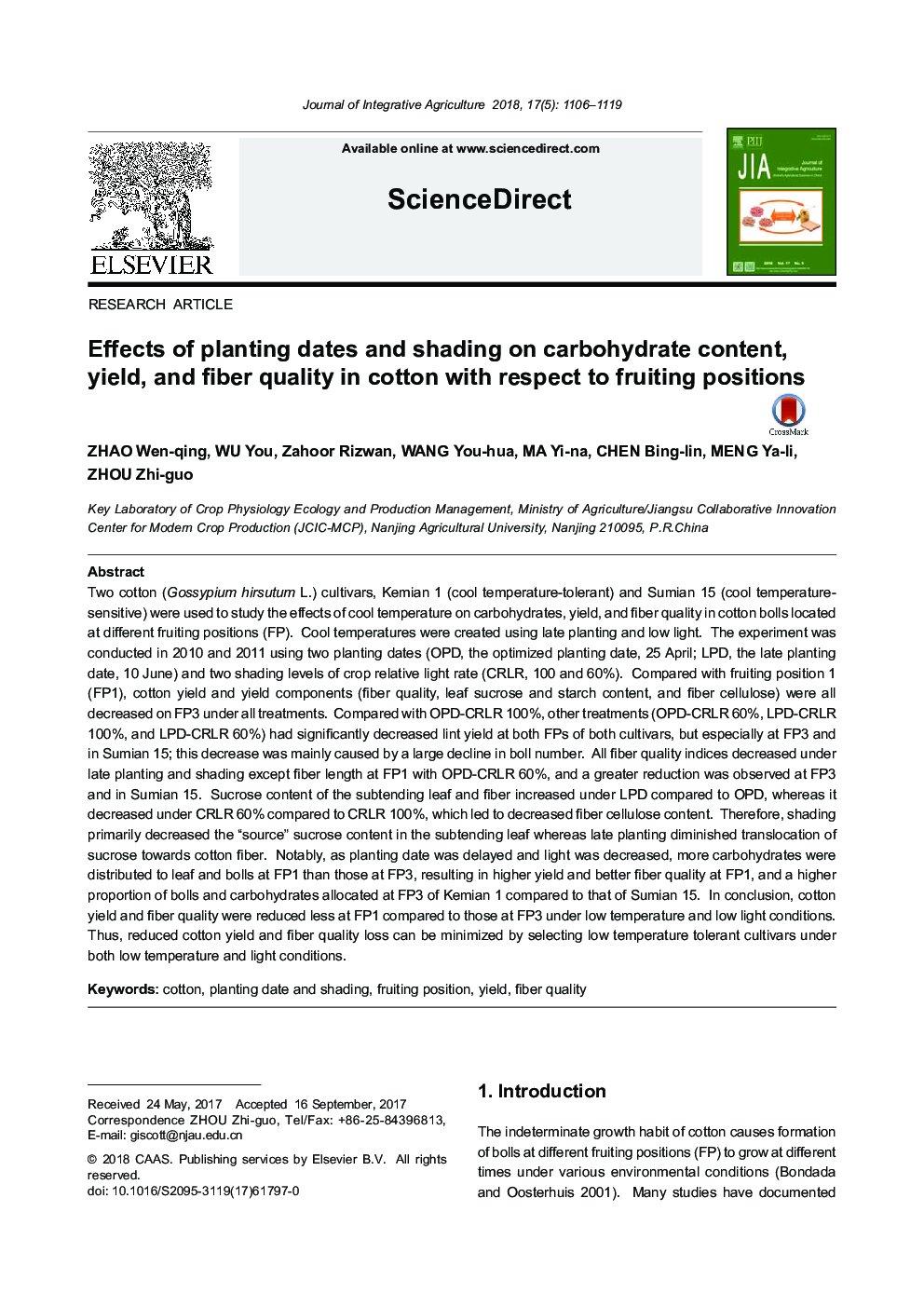| کد مقاله | کد نشریه | سال انتشار | مقاله انگلیسی | نسخه تمام متن |
|---|---|---|---|---|
| 8875643 | 1623697 | 2018 | 14 صفحه PDF | دانلود رایگان |
عنوان انگلیسی مقاله ISI
Effects of planting dates and shading on carbohydrate content, yield, and fiber quality in cotton with respect to fruiting positions
ترجمه فارسی عنوان
اثر تاریخ کاشت و سایه بر محتوای کربوهیدرات، عملکرد و کیفیت فیبر در پنبه با توجه به موقعیت های
دانلود مقاله + سفارش ترجمه
دانلود مقاله ISI انگلیسی
رایگان برای ایرانیان
کلمات کلیدی
پنبه، تاریخ کاشت و سایه موقعیت بدنی، بازده، کیفیت فیبر،
موضوعات مرتبط
علوم زیستی و بیوفناوری
علوم کشاورزی و بیولوژیک
علوم کشاورزی و بیولوژیک (عمومی)
چکیده انگلیسی
Two cotton (Gossypium hirsutum L.) cultivars, Kemian 1 (cool temperature-tolerant) and Sumian 15 (cool temperature-sensitive) were used to study the effects of cool temperature on carbohydrates, yield, and fiber quality in cotton bolls located at different fruiting positions (FP). Cool temperatures were created using late planting and low light. The experiment was conducted in 2010 and 2011 using two planting dates (OPD, the optimized planting date, 25 April; LPD, the late planting date, 10 June) and two shading levels of crop relative light rate (CRLR, 100 and 60%). Compared with fruiting position 1 (FP1), cotton yield and yield components (fiber quality, leaf sucrose and starch content, and fiber cellulose) were all decreased on FP3 under all treatments. Compared with OPD-CRLR 100%, other treatments (OPD-CRLR 60%, LPD-CRLR 100%, and LPD-CRLR 60%) had significantly decreased lint yield at both FPs of both cultivars, but especially at FP3 and in Sumian 15; this decrease was mainly caused by a large decline in boll number. All fiber quality indices decreased under late planting and shading except fiber length at FP1 with OPD-CRLR 60%, and a greater reduction was observed at FP3 and in Sumian 15. Sucrose content of the subtending leaf and fiber increased under LPD compared to OPD, whereas it decreased under CRLR 60% compared to CRLR 100%, which led to decreased fiber cellulose content. Therefore, shading primarily decreased the “source” sucrose content in the subtending leaf whereas late planting diminished translocation of sucrose towards cotton fiber. Notably, as planting date was delayed and light was decreased, more carbohydrates were distributed to leaf and bolls at FP1 than those at FP3, resulting in higher yield and better fiber quality at FP1, and a higher proportion of bolls and carbohydrates allocated at FP3 of Kemian 1 compared to that of Sumian 15. In conclusion, cotton yield and fiber quality were reduced less at FP1 compared to those at FP3 under low temperature and low light conditions. Thus, reduced cotton yield and fiber quality loss can be minimized by selecting low temperature tolerant cultivars under both low temperature and light conditions.
ناشر
Database: Elsevier - ScienceDirect (ساینس دایرکت)
Journal: Journal of Integrative Agriculture - Volume 17, Issue 5, May 2018, Pages 1106-1119
Journal: Journal of Integrative Agriculture - Volume 17, Issue 5, May 2018, Pages 1106-1119
نویسندگان
Wen-qing ZHAO, You WU, Zahoor Rizwan, You-hua WANG, Yi-na MA, Bing-lin CHEN, Ya-li MENG, Zhi-guo ZHOU,
